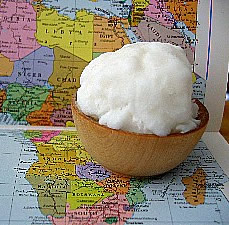Shea Butter ~ Africa's Golden Gift
By Lisa Maliga Copyright 2008-2013
Shea butter is a nut fat, as it is derived from the crushed nuts of the karite tree that grows wild in the African savannah, an area that comprises more than a dozen countries and is approximately the size of America. People from Ghana, Togo or Burkina Faso, three of the largest exporting countries of shea butter, are accustomed to the benefits. They massage it on their skin and hair; they cook with it, add it to soap, and it’s known to help people of all ages with accelerating the healing of minor cuts, burns, and scrapes. Those who try natural shea butter are amazed to discover that applying all natural shea butter onto their skin, a thin protective layer forms, that is relatively non-greasy!
Shea [Karite] Trees Grow In The Wild Shea butter comes from karite trees, which live for hundreds of years. Most wild [as opposed to cultivated which is very small scale at this time], karite trees are pollinated by fruit bats, which help to ensure the continued existence of the ‘tree of life’. The shea nuts aren’t picked from the trees as they must mature and fall from the trees where they are then collected. Women are responsible for the gathering and production of shea nuts and helping cultivate them into valuable shea butter. The process of harvesting the shea fruit is time consuming. While the ripe green, fleshy fruit is rich in ascorbic acid as well as vitamin B; it’s the kernels inside the nut that comprises the shea butter.
Making Shea Butter The nuts are first sorted and parboiled, and then left to dry in the sun for up to one week. When the shea nuts are dehydrated, they can either be stored for several weeks or months, or they go to the next step of shea butter production.
Crushing the dried nuts is done either with a wooden pestle, or a special press, which separates the nuts and the kernels. Next, the kernels are roasted in large metal pots and processed through a grinder, which results in a brown colored paste. This paste is processed a second time. The labor-intensive procedure continues with the mixing and kneading of the kernels after some water has been added. While this step of the shea butter making production goes on for several hours, it’s a vital step as it creates the shea butter itself. It’s still unrefined, but many people prefer the natural shea butter to the more refined versions. Also, there are places in Africa that have various types of shea refining machinery. For instance, the shea butter is filtered by a natural cold process method that strains the shea butter of any debris such as gourd pieces, dirt, leaves, etc. Most shea butter that is refined in Africa is usually free of hexane solvents that not only bleach and remove many of the vitamins and minerals, but can remain in the finished product.
Unrefined/Virgin Shea Butter
This type of shea butter has a wide range of colors and some differences in textures. Generally, unrefined, or virgin, shea butter is that which has been filtered [hopefully] and possibly refined at least once in the most natural cold process method. Beige, light or dark green, gray or dark tan are the colors that mark unrefined shea butter. The green colors come from shea nuts that are less mature than the beige colors. Shea colors are also dependent upon the time of year the nuts are harvested and processed, along with the region in which the shea nuts are selected from.
Unrefined shea butter maintains its vitamins, especially vitamins A and E, and minerals; it also retains its aroma. The scent of unrefined shea is what discourages many from trying this healing butter, as it can be an earthy combination of smoky and nutty. The aroma, may sometimes be strong, depending upon the shea butter and your sense of smell, disappears after it has been applied to your skin within minutes. Unrefined shea butter’s texture varies from smooth and creamy; like peanut butter, to hard, waxy and/or chunky. Those of you who have never been around shea butter would be put off if, upon opening a jar, you found a smelly and crunchy looking product! No matter what it looks like, it leaves your skin looking and certainly feeling smoother and softer than it did pre-application.
Refined Shea Butter This type is usually white to cream colored, has no discernable nutty/smoky scent, and is smooth and creamy. The difficulty with ultra or even refined shea butter, is in knowing whether that product has been commercially refined to remove its minerals and vitamins with a hexane solvent. Also, shea butter can be bleached to make it appear even lighter. One way to determine a shea butter’s authenticity is to see if it has been cold-pressed, sometimes called cold-processed or expeller-pressed. The Refined shea, which ranges in color from white to beige has had some of its vitamin/mineral properties removed in the process of refining, but retains a bit of a beige color and nutty aroma. The texture can be creamy or chunky. The ideal shea butter would feel creamy and smooth and be absorbed into your skin quickly. Also, the nutty and/or smoky scent should be lighter. Shea butter can be mixed with fragrances and essential oils to completely change the aroma, making it sweet, spicy, fruity, floral, herbal, etc.
Shea Butter’s Benefits
Shea butter is a skin soothing nut fat that can be used in various ways:
- All-natural hair conditioner.
- Promotes quicker healing of small wounds, burns, cuts and scrapes.
- Natural makeup remover.
- Safe to use on babies, children and adults.
- Helps prevent and soothe sunburns.
- High in vitamins A and E.
- Dry skin moisturizer.
- Soothes sore, overworked muscles.
- Natural lip balm.
- Helps restore elasticity of aging skin.
Want to read more about shea butter? If so, check out my eBook Nuts About Shea Butter, where you can learn about other varieties, see more photos and get some recipes.


